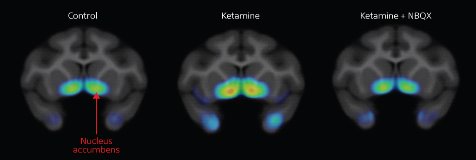Mar. 14, 2014 Research Highlight Medicine / Disease
Serotonin boost explains an anesthetic’s antidepressant effect
Molecular imaging reveals that the anesthetic drug ketamine helps to reverse depression by altering serotonin signaling in the brains of monkeys
 Figure 1: A positron emission tomography (PET) scan of a monkey brain showing that ketamine treatment activates serotonin 1B (5-HT1B) receptors in the nucleus accumbens. This activation is reversed by the addition of NBQX, a drug known to block ketamine’s antidepressant effect. © 2014 Hirotaka Onoe, RIKEN Center for Life Science Technologies
Figure 1: A positron emission tomography (PET) scan of a monkey brain showing that ketamine treatment activates serotonin 1B (5-HT1B) receptors in the nucleus accumbens. This activation is reversed by the addition of NBQX, a drug known to block ketamine’s antidepressant effect. © 2014 Hirotaka Onoe, RIKEN Center for Life Science Technologies
The anesthetic drug ketamine has recently been shown to have a rapid antidepressant effect in psychiatric patients who do not respond to other medications. However, physicians still do not fully understand what the drug does in the brain. Using molecular imaging techniques, a research team led by Hirotaka Onoe and colleagues from the RIKEN Center for Life Science Technologies has now discovered that ketamine increases the activity of serotonin in brain areas involved in regulating motivation and mood1.
Many antidepressants target the re-uptake of serotonin, a neurotransmitter molecule with a range of important functions that has been linked to feelings of happiness. To investigate the possible effect of ketamine on serotonin signaling, Onoe’s team, in collaboration with researchers from Karolinska Institutet in Sweden, used a molecular imaging technique called positron emission tomography (PET) to study the brains of four rhesus macaque monkeys before and after ketamine administration. PET allows researchers to map the location of radioactively labeled ‘tracer’ molecules in the brain in three dimensions. Onoe’s team used two tracers linked to serotonin signaling—one bound to the serotonin 1B receptor (5-HT1B) and another bound to the serotonin transporter (SERT).
The researchers found that ketamine significantly affected serotonin neurotransmission in two specific regions of the brain: the nucleus accumbens and the ventral pallidum, both of which play pivotal roles in the brain’s reward circuit. Ketamine significantly increased the binding of the tracer chemical to the 5-HT1B receptor, indicating an upregulation of this key serotonin mediator. At the same time, the drug significantly reduced binding to SERT, a transporter that terminates the action of serotonin in the neural synapse.
“Ketamine might modulate brain serotonergic neurotransmission by regulating its receptor and transporter expression on the synaptic membrane,” says Onoe. “Since the nucleus accumbens and the ventral pallidum are known to be critical parts of the neural circuit associated with motivation, ketamine might directly affect motivation in depressive patients.”
The researchers also investigated the effects of combining ketamine with a drug called NBQX, which had previously been reported to attenuate the effects of ketamine in rodents. They found that addition of NBQX interfered with the action of ketamine on 5-HT1B receptors (Fig. 1) but had no impact on SERT levels. The findings suggest that much of ketamine’s antidepressant action appears to be due to an increase in activity of postsynaptic 5-HT1B receptors in the nucleus accumbens and ventral pallidum—and not as a result of the drug’s effect on SERT.
References
- 1. Yamanaka, H., Yokoyama, C., Mizuma, H., Kurai, S., Finnema, S. J., Halldin, C., Doi, H. & Onoe, H. A possible mechanism of the nucleus accumbens and ventral pallidum 5-HT1B receptors underlying the antidepressant action of ketamine: A PET study with macaques. Translational Psychiatry 4, e342 (2014). doi: 10.1038/tp.2013.112
